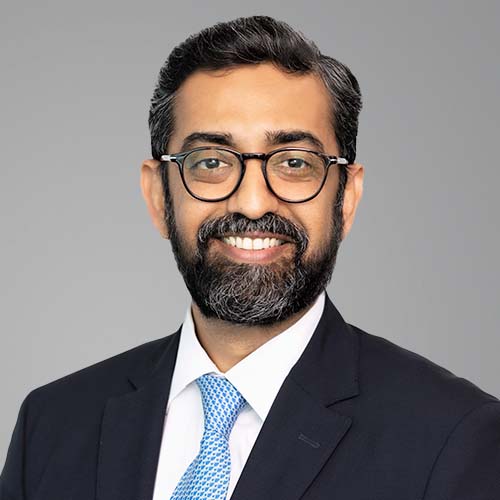How UBP is deepening its client-centric investment proposition in Asia?
In an increasingly complex investment landscape, agility and personalization are fast becoming the currencies of trust. Clients are no longer looking for off-the-shelf portfolios. They want guidance tailored to their needs, access to niche opportunities, and investment partnerships that adapt to change.
Paras Gupta, Head of Investment Services Southeast Asia and Head of DPM Asia at Union Bancaire Privée (UBP), sat down with Hubbis in Singapore to share how the firm is shaping its strategy in response to this demand. In this conversation, Gupta outlines UBP’s investment philosophy, its strengths in alternatives, and why discretionary portfolio management (DPM) is slowly but surely gaining traction in Asia.
A Pure Play Investment House with Flexibility at Its Core
UBP is a pure wealth and asset management house, and according to Gupta, that specialization enables sharper client focus. "We’re not in investment banking. We’re not in retail banking. Our entire DNA is centred on wealth and asset management," he says.
That DNA, Gupta explains, is built around three guiding principles: solution-driven thinking, flexibility, and personalization. "We aren’t structured to say 'no' by default," he says. "We explore, we customize, and we often find ways to meet client needs that larger institutions may not accommodate."
He emphasizes that this isn’t marketing rhetoric. "I've been at UBP for over eight years, and I've seen how this agility and flexibility is played out. From product design to portfolio construction, we pull together expertise from across geographies and business lines to build tailored, high-touch solutions."
Alternatives as a Differentiator: Hedge Funds and Private Markets
While many wealth managers now offer access to alternatives, Gupta is quick to point out that UBP’s history in this space runs deep. “We’ve been investing in hedge funds since 1972, long before the asset class became mainstream. It’s a core area of competence for us,” he says.
But the differentiation doesn’t stop at access. UBP takes an integrated approach, embedding hedge funds into holistic portfolios rather than offering them only as standalone options.
“It’s not about giving clients a few off-the-shelf strategies and asking them to choose. We curate portfolios that fit into broader objectives.”
Paras Gupta
In private markets, the growth story is equally strong. “When I joined UBP, we only had a few people globally covering private markets. Today we have over 30,” he notes. The focus initially was on niche investment strategies, and curated co-investment opportunities across private equity, infrastructure, real estate, and other income-generating strategies. This focus has expanded to include open-ended evergreen private market strategies. “The idea is to take a portfolio-based approach and help clients build a diversified portfolio of private market assets”
Putting It Together: Tailored Execution Over Shelf Offerings
While most banks offer similar products, Gupta believes UBP’s real value lies in how those products are utilized in the clients’ portfolios. “If you look at any institution, the offerings don’t look that different. What matters is the advice you give and how you incorporate these products in client portfolios. That’s where we aim to stand out.”
He describes a highly interactive process that focuses on understanding client objectives, preferences, risk appetite and experience. "We don’t assume clients need everything. We listen, design, and adapt. And we maintain an ongoing dialogue to ensure alignment as circumstances evolve."
Discretionary Management: Quiet Momentum in Asia
Discretionary portfolio management remains underpenetrated in Asia, but Gupta sees signs of steady evolution. "Everyone talks about it, but uptake is still low. That said, we are seeing movement.”
He attributes past resistance to cultural and generational factors. “In Europe, wealth has transitioned over generations. In Asia, many clients are still first-generation wealth creators who are hands-on with their money.”
However, Gupta believes that change is underway, driven by three main forces:
- Product evolution: DPM offerings have become more sophisticated and customized, moving away from static, risk-bucket models. "Clients can now have actively managed bottom-up research driven single asset class portfolios or blended solutions that reflect their views."
- Regulatory environment: Evolving regulatory expectations make discretionary portfolios a more efficient way to manage complexity.
- Market experience: "Nothing educates like a downturn in financial markets," Gupta says. As volatility returns, more clients are recognizing the value of professional management over self-directed trading.
"In a bull market, everyone makes money. It’s during drawdowns that clients realize the importance of risk-managed, actively overseen and managed portfolios."
A Modern DPM Model: Transparent, Engaged, and Adaptive
UBP’s discretionary model is evolving to meet these client shifts. Gone are the days of static multi-asset portfolios managed behind the scenes.
Today, Gupta says, clients demand transparency and engagement. "Our DPM managers are not sitting in the background. They engage regularly and meaningfully, with clients. They discuss changes, performance, market developments."
Moreover, as markets evolve, portfolios themselves are becoming more dynamic. "We’re seeing strong interest in single-asset class mandates built bottom-up with high degree of granularity across sub-asset classes and direct exposure. —a portfolio of securities that clients can understand and track line by line."
This modular approach also allows larger clients to allocate mandates across different banks. "They might say, 'UBP, you're good at fixed income, manage that sleeve.' That kind of specialization is becoming common."
People-Driven, Not Just Tech-Led
Even as digital tools proliferate, Gupta believes that the human element remains central. “We are not an AI-led firm. We’re in the people business. Personalized advice still matters.”
That includes access to real decision-makers. "Whether it’s our discretionary portfolio managers or investment specialists, clients speak directly to the experts. That’s critical for trust."
Looking Ahead: Staying True to the Core
Despite the evolving environment, Gupta sees UBP’s core philosophy remaining consistent: client-centricity, flexibility, and investment depth.
"We’re not trying to be everything to everyone. But for clients who value bespoke advice, alternatives access, and ongoing engagement, we think we offer something distinct."
In a market increasingly filled with noise, UBP’s proposition is simple: clarity through customization, and trust through continuity.
Key Priorities
For Paras Gupta, steering clients through a changing investment landscape starts with alignment. “The number one priority for us is to move more into the managed solutions space,” he says. “It’s a win-win approach that reduces conflicts of interest and brings client and bank interests closer together.”
This shift towards managed solutions—where discretionary mandates are structured as certificates, funds, or bespoke portfolios—is driven by the belief that the next market phase will demand a more disciplined, professionalized form of asset management. “The last 15 years were defined by a certain market rhythm. But we’re entering a period where agility and portfolio responsiveness will be critical,” Gupta adds. For him, managed solutions offer a framework to navigate that volatility with control and foresight.
Alongside this discretionary push, Gupta’s second priority is a deeper transformation in advisory services. While advisory remains a significant pillar for banks in the region, Gupta sees a need to evolve beyond a purely transactional mindset. “The industry, by and large, has been very transactional in how advisory is delivered,” he notes. “What we need now is a more holistic approach—even in advisory, where the client retains control of decisions.”
That holistic approach means embedding more structure, discipline, and long-term thinking into client engagements—even when portfolios aren’t managed directly by the bank. “It’s about providing real value, not just recommendations,” Gupta says. “Clients may be calling the shots, but we need to guide them with broader context, strategy, and continuity.”
The third priority, Gupta emphasizes, is protecting client wealth in what he expects to be a period of increased market uncertainty. “We are in the business of managing wealth. In times like these, capital preservation often takes precedence over returns,” he explains. With rising volatility, preserving the core of a client’s portfolio becomes not just prudent—but essential.
These three priorities—discretionary alignment, evolved advisory, and capital preservation—form the foundation of Gupta’s outlook for the next 18 months. Taken together, they reflect a broader shift in private banking: away from product-led engagement, and toward value-driven, risk-aware wealth stewardship.
Into the Future: Balancing Technology with Human Judgment
Paras Gupta doesn’t deny that the next decade in wealth management will be shaped by technology. “There are no two ways about it,” he says. “Artificial Intelligence (AI), online platforms, and quantitative tools are already redefining how portfolios are built and managed.”
Sophisticated digital platforms are enabling clients to create customized portfolios at scale, while AI is increasingly embedded in portfolio construction and risk modelling. Yet Gupta believes this wave of automation is not the endgame—at least not yet. “What will still have a very important place is the human element,” he says.
“There’s a massive behavioural side to what we do, and managing those biases still requires human judgment.”
While he’s quick to embrace technology—especially in its ability to enhance productivity—Gupta draws a clear distinction between task automation and advisory depth. “We’re using AI to reduce time on routine tasks, which allows portfolio managers to focus more on high-value decisions,” he explains. “That’s where the real benefit is today.”
Still, he acknowledges that technology’s role is evolving fast. “In five to ten years, we’ll likely see much more sophisticated use of AI. But for now, I don’t see it replacing the human aspect—especially when it comes to understanding client emotions, fears, and biases,” Gupta says. He points to behavioural finance as a critical component of investment success, one that requires nuanced conversations and trust—something algorithms have yet to replicate.
Looking further ahead, Gupta doesn’t rule out deeper shifts. “In 20 or 30 years, we may evolve to a different level altogether,” he notes. But in the foreseeable future, he envisions a model of coexistence—where technology enhances decision-making, but doesn’t replace the advisor-client relationship.
Markets, too, are in constant flux. “If you look at the last 50 to 70 years, market behaviour has never been static. New factors will continue to emerge, and AI will need to adapt as well,” he says. “That adaptation, in my view, still requires human insight.”
For Gupta, the future of investment management lies in integration: of machine precision with human perception, of digital tools with behavioural understanding. It’s not about man versus machine—but about learning to navigate complexity together.









